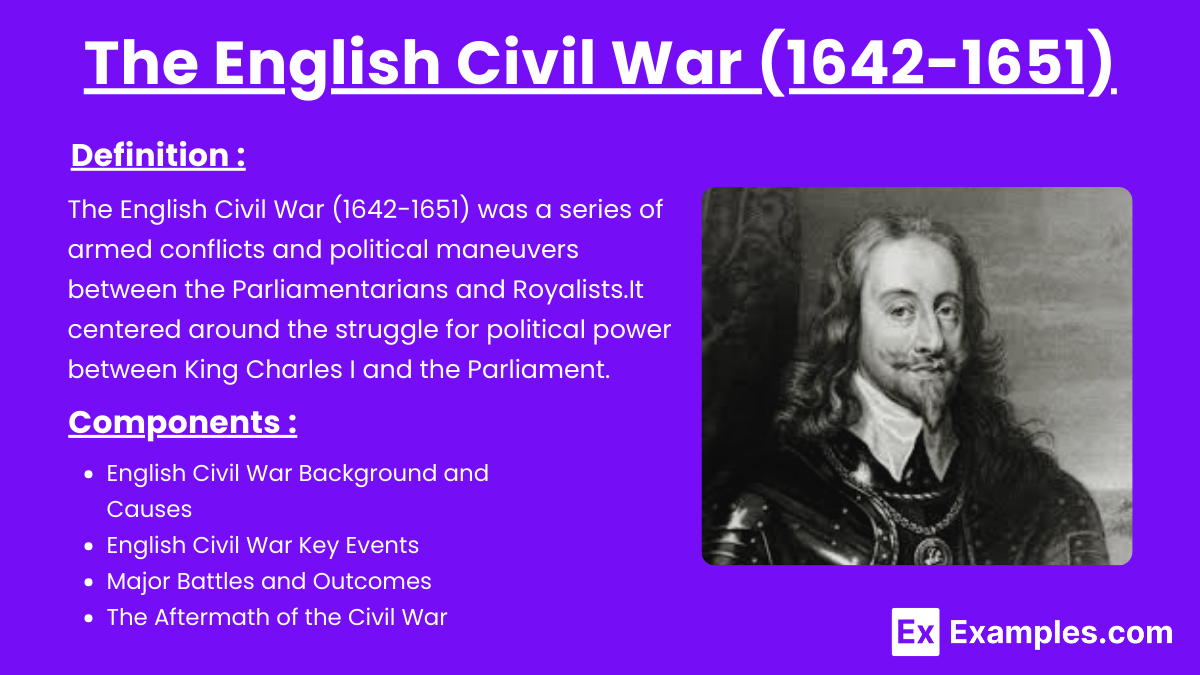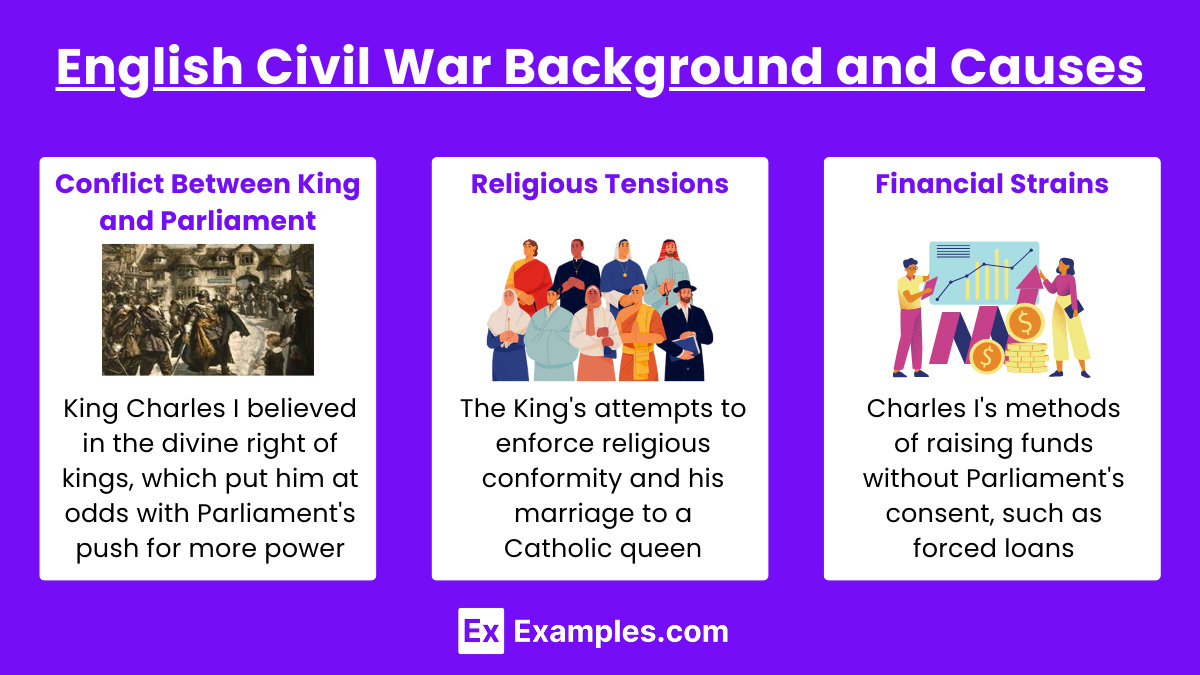The English Civil War (1642–1651) and the Glorious Revolution (1688) were defining events in British history, marking the clash between royal authority and parliamentary power. The Civil War saw the overthrow of King Charles I and the establishment of a brief republican Commonwealth. The Glorious Revolution, a bloodless coup, deposed James II and established constitutional monarchy under William III and Mary II. These events reshaped the English political landscape, leading to the development of a constitutional government and the protection of individual rights.
Learning Objectives
By studying the English Civil War and the Glorious Revolution for the AP European History exam, you should understand the political, religious, and economic causes of the conflict, including the tension between monarchy and Parliament. Learn about key events and figures, such as Charles I, Oliver Cromwell, and William of Orange, and their roles in shaping the outcomes. Recognize the significance of these events in establishing constitutional monarchy, parliamentary democracy, and the protection of civil liberties in England, influencing broader European political developments.
The English Civil War

The English Civil War (1642-1651) was a series of armed conflicts and political maneuvers between the Parliamentarians ("Roundheads") and Royalists ("Cavaliers"). It centered around the struggle for political power between King Charles I and the Parliament. Key issues included disputes over religious freedoms, the role of monarchy versus parliamentary sovereignty, and financial control. The war resulted in the trial and execution of Charles I, the abolition of the monarchy, and the establishment of a short-lived Commonwealth under Oliver Cromwell. The conflict profoundly influenced English governance, leading to the eventual establishment of a constitutional monarchy.
1. English Civil War Background and Causes

The English Civil War was the result of deep-seated political, religious, and economic conflicts. Key causes included:
Conflict Between King and Parliament: King Charles I believed in the divine right of kings, which put him at odds with Parliament's push for more power and a role in governance.
Religious Tensions: The King's attempts to enforce religious conformity and his marriage to a Catholic queen alarmed Protestant subjects, especially the Puritans.
Financial Strains: Charles I's methods of raising funds without Parliament's consent, such as forced loans and the controversial "Ship Money" tax, created widespread resentment.
2. English Civil War Key Events
The Short Parliament (1640): Charles I summoned Parliament to approve funds for his military campaigns but dissolved it after only three weeks when they refused.
The Long Parliament (1640–1660): This Parliament was instrumental in passing the Triennial Act, which required Parliament to be summoned every three years, and in curtailing the King's powers.
Outbreak of War (1642): The war began after failed negotiations and the King's attempt to arrest five members of Parliament. The country split into Royalists (Cavaliers) and Parliamentarians (Roundheads).
3. Major Battles and Outcomes
Battle of Edgehill (1642): The first major battle ended inconclusively.
Battle of Marston Moor (1644): A decisive Parliamentarian victory that weakened Royalist forces in the north.
Battle of Naseby (1645): Marked a turning point in favor of the Parliamentarians, leading to the eventual capture and execution of Charles I in 1649.
4. The Aftermath of the Civil War
Trial and Execution of Charles I (1649): Marked the first time a reigning monarch was tried and executed by his own people.
The Commonwealth and Protectorate (1649-1660): England was declared a republic under the leadership of Oliver Cromwell.
Restoration of the Monarchy (1660): Charles II was invited to take the throne, restoring the monarchy but with conditions that limited royal power.
The Glorious Revolution (1688-1689)

The Glorious Revolution, occurring between 1688 and 1689 in England, was a pivotal event that marked the peaceful overthrow of King James II and the accession of William III and Mary II to the English throne. This revolution was "glorious" due to its relatively bloodless nature and its significant constitutional implications. James II's Catholicism and autocratic tendencies sparked fear among Protestant leaders and the general populace, leading to a call for change. William of Orange, encouraged by political leaders, invaded England, prompting James II to flee to France. The revolution established the supremacy of Parliament over the monarchy, enshrined in the Bill of Rights (1689), which restricted royal powers and affirmed parliamentary sovereignty.
1. Causes
Religious Fears: King James II's Catholicism and attempts to promote religious tolerance for Catholics caused fear among Protestant subjects.
Political Concerns: James II's efforts to centralize power and bypass Parliament alarmed both Whigs and Tories.
2. Key Events
The Invitation to William of Orange: A group of English nobles invited William of Orange and his wife Mary (James II's Protestant daughter) to take the English throne.
William's Invasion (1688): William landed in England with a substantial army, leading to James II's flight to France.
The Declaration of Rights (1689): Parliament issued the Declaration of Rights, which limited the powers of the monarchy and established parliamentary sovereignty.
3. Consequences of the Glorious Revolution
Constitutional Monarchy: The Glorious Revolution established the foundation for a constitutional monarchy where the king or queen ruled in partnership with Parliament.
Bill of Rights (1689): This document cemented various rights and liberties, including regular parliaments, free elections, and freedom of speech within Parliament.
Religious Toleration Act (1689): Granted freedom of worship to non-Anglican Protestants, though Catholics and non-Christians were still excluded.
Examples of English Civil War and the Glorious Revolution
Roundheads and Cavaliers
The English Civil War featured two main factions: the Roundheads, who supported Parliament, and the Cavaliers, who supported King Charles I.The New Model Army
A disciplined and effective fighting force established by Parliament during the Civil War, led by Oliver Cromwell.The Rump Parliament
The Parliament that remained after Pride's Purge, which saw the exclusion of MPs not loyal to the army, leading to the trial and execution of Charles I.The Exclusion Crisis
A political conflict during the reign of Charles II over whether his Catholic brother, James II, should be excluded from the throne.The Toleration Act of 1689
Passed after the Glorious Revolution, this act granted religious freedom to Protestant dissenters, although it excluded Catholics and non-Christians.
Practice Test Questions on English Civil War and the Glorious Revolution
Question 1:
What was a primary cause of the English Civil War?
A) Disputes over the succession of the throne
B) Tensions between the monarchy and Parliament over authority
C) Religious conflicts between Catholics and Protestants
D) Economic depression due to poor harvests
Answer: B) Tensions between the monarchy and Parliament over authority
Explanation: The English Civil War (1642–1651) primarily arose from the struggle for power between King Charles I and Parliament. The King believed in the divine right of kings, which gave him absolute authority, while Parliament sought to limit his powers and protect their own rights. This disagreement over governance and authority led to a series of conflicts, ultimately resulting in the war.
Question 2:
What was a significant outcome of the Glorious Revolution of 1688?
A) The restoration of the Catholic monarchy in England
B) The establishment of a constitutional monarchy
C) The abolition of the monarchy in favor of a republic
D) The beginning of the Tudor dynasty
Answer: B) The establishment of a constitutional monarchy
Explanation: The Glorious Revolution led to the overthrow of King James II and the ascension of William III and Mary II to the throne. It marked the end of absolute monarchy and the establishment of a constitutional monarchy in England. This change was solidified through the Bill of Rights in 1689, which limited the powers of the monarch and ensured the supremacy of Parliament.
Question 3:
Which document, established during the Glorious Revolution, significantly influenced the development of modern democracy?
A) The Magna Carta
B) The English Bill of Rights
C) The Act of Supremacy
D) The Petition of Right
Answer: B) The English Bill of Rights
Explanation: The English Bill of Rights, enacted in 1689, was a crucial document that laid the foundation for modern parliamentary democracy. It established key principles such as the requirement for regular parliaments, free elections, and freedom of speech within Parliament. The Bill of Rights also protected certain rights of individuals, including the prohibition of cruel and unusual punishment, thus influencing future democratic documents like the U.S. Constitution and the Universal Declaration of Human Rights.


